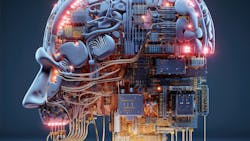AI’s Impact on Engineering Jobs: What Can We Do About It?
What you’ll learn
- How AI is taking jobs away.
- What you can do to prevent AI from supplanting your career.
- Top engineering schools.
Welcome to the first edition of "Engineering on Friday." Want to know what I mean? Engineering on Friday comes in two flavors:
1. You work harder than you ever have, meeting some ridiculous deadline. Sweaty all day, skipping lunch, doing more work in a day than in a previous month.
2. Sweet FA. In other words–not a dang thing. Not sweaty, long lunches, and maybe a Nerf battle in the whole office.
That #2, I find it to be the most important. Pressure is off. Creative minds working toward no goal. What will happen?
It’s a time I like to reflect, to chill, wonder if this engineering thing was worth dedicating a life to–or is opening a comic book store still an option?
Nonetheless, I will explore being human in the engineering world, in all flavors. Follow along when you can...
Onward.
I grew up watching shows like The Jetsons. Like most kids, I used to dream about how artificial intelligence (AI) and robotics might alter our society. Since the first “thinking machines” of the 1800s, people have feared a world in which machines could out-mind man. I, like most people probably, envisioned futuristic cities with stainless-steel sky rises, space suits, and robots as far as the eye could see.
We all predicted a world in which we could outsource easy, mundane tasks like vacuuming (even the Jetsons had Rosie). But did anyone predict we would build machines so intelligent they could replace hundreds of millions of white-collar workers as well? I, for one, had not. Regardless of my lack of foresight, that day is here.
Without responsible intervention, artificial intelligence is on track to replace 300 million jobs worldwide.
I spoke a little bit about this in the article “Is AI on Track to Replace Engineers Across Multiple Industries?” I wanted to dive a little deeper into the issue and here’s what I found.
AI to Replace 300 Million Full-Time Jobs
According to a report released by Goldman Sachs economists earlier this year, as many as 300 million full-time jobs could be eliminated globally by new advances in generative AI. Note this figure doesn’t include jobs that are already on track to be replaced by conventional AI. One example is Amazon’s Sparrow application, which can recognize inventory items in a warehouse and prepare products for shipment, all without the aid of human intervention.
What is Generative AI?
Where conventional AI is defined as a machine’s ability to perform cognitive functions typically congruent with human thought (e.g., natural language processing, speech recognition, vision, etc.), generative AI is a different beast entirely.
Generative AI is defined as machine-learning programs that use algorithms to generate “new” content. Generative AI programs can create new audio, graphics, images, text, simulations, computer code, and videos all on their own—and it will only get more accurate with time. This means a variety of white-collar jobs will be at risk of computerization, including graphic design, accounting, paralegal, writing, and engineering, to name a few.
How Generative AI Works
Generative AI utilizes models inspired by the neural networks of human brains. This modeling enables machines to analyze structures within existing data to “learn” and create “new” content. For example, ChatGPT can identify natural language patterns and analyze a prompt against millions or billions of bytes of data that match that prompt. It then returns content informed by the patterns and structures of existing data.
For example, let’s say you ask ChatGPT to write you a highly rated speech for a board meeting. The program will analyze raw data that seems related to highly rated board-meeting speeches, find patterns that identify factors that made those speeches successful, and give you a speech that should—at least statistically—prove to include elements of “highly rated” board-meeting speeches.
But Can Generative AI Actually “Think”?
The question of whether or not machines can truly think or comprehend topics like the human mind has been debated since the ideation of the “thinking machine.” The answer to the question depends on who you ask and how we define thinking.
Some say computers can’t truly think because machines are incapable of truly understanding the data processed. For instance, ChatGPT can generate an essay about a visit to a French bistro. But a computer will never understand the experience of sitting at a French bistro, people-watching. It’s not capable of mulling over the nuanced stimuli to be encountered there, processing it abstractly, and writing about it later in the way that humans can.
To be sure, ChatGPT can absolutely write an essay about a visit to a bistro by analyzing data from other peoples’ visits to bistros. However, it will always miss that element that makes what we do essentially human.
Still, that won’t keep AI from displacing millions of workers worldwide.
Engineering Could be Hit… Hard
No one knows exactly how hard any industry will be affected by AI, but there are predictions.
Software engineers are expected to be hit especially hard because generative AI can write computer code, too. ChatGPT not only “writes” high-school-level essays, but it’s also able to generate code that works (not all of the time, but nonetheless). And it can generate functional code blocks in seconds, compared to the days or weeks it might take a software engineer to write the same code.
ChatGPT isn’t the only generative AI program on the market either. Other tools can analyze errors in code, test code, and even problem-solve. This puts test engineering jobs at risk for computerization as well.
Across other engineering disciplines, AI is ever-present. New programs like Flux.ai and DeepPCB use AI to create PCB layouts, which would impact PCB layout engineers. And programs like ChatGPT and Ansys Discovery can create generative CAD designs, impacting CAD design engineers.
But will AI completely replace human engineers? Thankfully, it seems unlikely.
AI as a Tool for Enhanced Productivity
To be sure, some roles are expected to become obsolete as a result of advances in artificial-intelligence technologies. And while the role of a software or PCB layout engineer won’t be eliminated completely, the number of people needed to perform the same role is expected to decrease significantly.
For those of us who do remain employed full-time, AI is expected to become a tool that enhances productivity. Unfortunately, the workers who remain will likely need to become even more skilled and AI-competent, while companies continue to profit from enhanced productivity without the need for an increased workforce (or higher pay for skilled workers due to intense competition for the few jobs that remain). In fact, global GDP could increase by 7%, or close to $7 trillion, without necessarily expected increases in worker salaries.
Is There Really Room for Everyone in the Workspace?
AI isn’t all bad. According to the World Economic Forum, AI could also create as many as 97 million jobs by 2025. But what about the other 203 million jobs that might become obsolete?
To combat the threat of technology, some have argued for a basic universal income, especially since continued advances in technology have already impacted income equality and are likely to continue to do so. Others, including Elon Musk, have argued for government mitigation, in particular because some of the potential applications of AI include weaponization. (Read the White House’s report on the impact of AI on the workforce here.)
For the rest of us, all we can do is diversify our skillsets, try to be strategic, and hope for the best.
Engineering Stats
According to a study, undergraduate degree programs reported 633,502 students enrolled in 2018. That same year, 131,937 students graduated, with the largest disciplines being mechanical engineering (31,936 graduates), computer science (19,082 graduates), and electrical engineering (13,767 graduates). There were also 93,559 students enrolled in graduate engineering programs that year—66,340 of whom graduated in 2018. All figures pointed to increasing rates of enrollment expected each year.
According to the U.S. Bureau of Labor Statistics, there were approximately two million engineers, 700,000 engineering technicians and technologists, and 4.1 million computational professionals in the U.S. workforce in 2018. These numbers have likely grown significantly in the past half-decade.
Engineering has long been considered a safe and prestigious career. What’s an engineer to do?
Thankfully, very smart professors at top engineering institutions are leading the way.
Top Engineering Schools
According to the annual U.S. News ranking, the top 10 schools for engineering (in order) are the Massachusetts Institute of Technology (MIT), Stanford University, the University of California at Berkeley, Purdue University-West Lafayette, Carnegie Mellon University, Georgia Institute of Technology, California Institute of Technology, University of Michigan-Ann Arbor, University of Texas-Austin, and Texas A&M University-College Station.
A combination of factors makes the top schools leading institutions. At MIT, faculty members are some of the best in the world, with ample awards to show for it. As such, it comes as no surprise that MIT already has a task force around how AI will impact future workers.
Strong research has historically set Stanford University apart as a leader. As such, Stanford already has a research lab dedicated to the future of work and other factors of the digital economy. And schools like Carnegie Mellon University have curated programs in which graduate students can explore how AI is impacting engineering, so that current students can perhaps help prepare future generations for what’s to come.
Most information released seems to agree that AI won’t completely eliminate jobs, but it will radically shift how we work and likely the skills we’ll need to stay competitive in the job market.
What More Can Be Done?
We can’t deny the reality of what’s coming. We can only prepare.
Corporations slash positions regularly to maximize the bottom line. The very nature of our capitalistic society will likely drive the adoption of AI applications faster than any other factor. It isn’t a matter of whether or not AI will impact your industry; it’s a matter of when it will radically shift your workplace.
If Elon Musk is pushing for government mitigation, we can assume there’s at least the potential for a very grim future ahead. Stay active in local government and do what you can in your local region to petition regulation around the use of AI to replace full-time workers. On the bright side, we’re at least having these conversations now on a national scale while there’s still time to act.
If you’re early into your career, or even mid-level, diversify your skillset to learn how to use AI-powered tools and set yourself apart from other engineers (who, unfortunately, are now much more adequately defined as your competition than ever before). Or don’t, and hopefully, universal basic income will take care of the rest.
As always, keep your heads up. Engineers have made the very AI applications we’re coming to fear. If anyone can devise a hack to save us from a robot revolt, it’s the very hands that built those bots.
Check out our AI Quick Poll and leave a comment below.
About the Author
Cabe Atwell
Technology Editor, Electronic Design
Cabe is a Technology Editor for Electronic Design.
Engineer, Machinist, Maker, Writer. A graduate Electrical Engineer actively plying his expertise in the industry and at his company, Gunhead. When not designing/building, he creates a steady torrent of projects and content in the media world. Many of his projects and articles are online at element14 & SolidSmack, industry-focused work at EETimes & EDN, and offbeat articles at Make Magazine. Currently, you can find him hosting webinars and contributing to Electronic Design and Machine Design.
Cabe is an electrical engineer, design consultant and author with 25 years’ experience. His most recent book is “Essential 555 IC: Design, Configure, and Create Clever Circuits”
Cabe writes the Engineering on Friday blog on Electronic Design.

